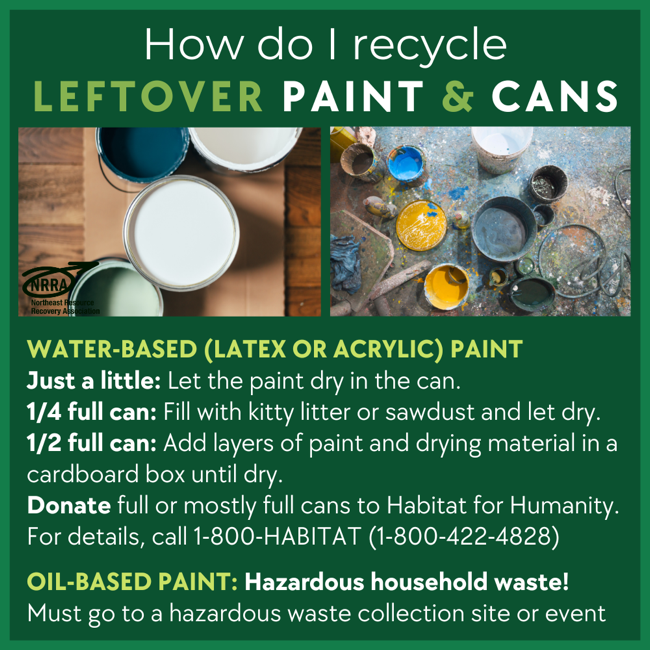How do I Recycle: Leftover Paint and Cans?

YOU ASKED: HOW DO I DISPOSE OF MY OLD PAINT?
The first step in throwing away old paint is to first figure out what TYPE of paint it is - water-based or oil-based.
Water-based paint will be labeled "acrylic," "latex," or "water-based." Another hint is that paint can be cleaned off of hands with soap and water and has low VOCs (Volatile Organic Compounds). Most paint now sold at big-box stores is water-based. Here's how to dispose of water-based paint:
- JUST A LITTLE PAINT: remove the paint can lid and let it dry out. Once dried, you can toss with your household trash.
- 1/4 CAN OF PAINT: add a drying agent like kitty litter, cardboard scraps, or sawdust to soak up the paint and let it dry. Once dried, you can toss with your household trash.
- 1/2 CAN OF PAINT: layer paint and drying agents (listed above) in a cardboard box until dried. Once dried, you can toss with your household trash.
- FULL OR MOSTLY FULL PAINT: as long as it hasn't gone bad, you can DONATE the paint to Habitat for Humanity. Find a location near you by calling 1-800-HABITAT (1-800-422-4828).
Oil-based paint may be labeled "gel paint," "enamel," or "oil based." It has a strong smell and can only be cleaned with mineral spirits or turpentine. Because of the high VOCs, oil-based paint sale is restricted in most states.
Oil-based paint is considered Household Hazardous Waste and must be disposed of at a hazardous waste collection site or event. Air drying liquid solvent-based paint is not recommended, but if the paint has completely solidified in a closed can, you can dispose of it in your regular trash.
♻️ For more information about disposing paint in New Hampshire: https://www.des.nh.gov/blog/pollution-prevention-tips-paint
♻️ For more information about disposing paint in Vermont or Maine: https://www.paintcare.org/
This material is based upon work supported under a grant by the Rural Utilities Service, United States Department of Agriculture. Any opinions, findings, and conclusions or recommendations expressed in this material are solely the responsibility of the authors and do not necessarily represent the official views of the Rural Utilities Service. Rural Community Assistance Partnership, Inc., is an equal opportunity provider and employer.